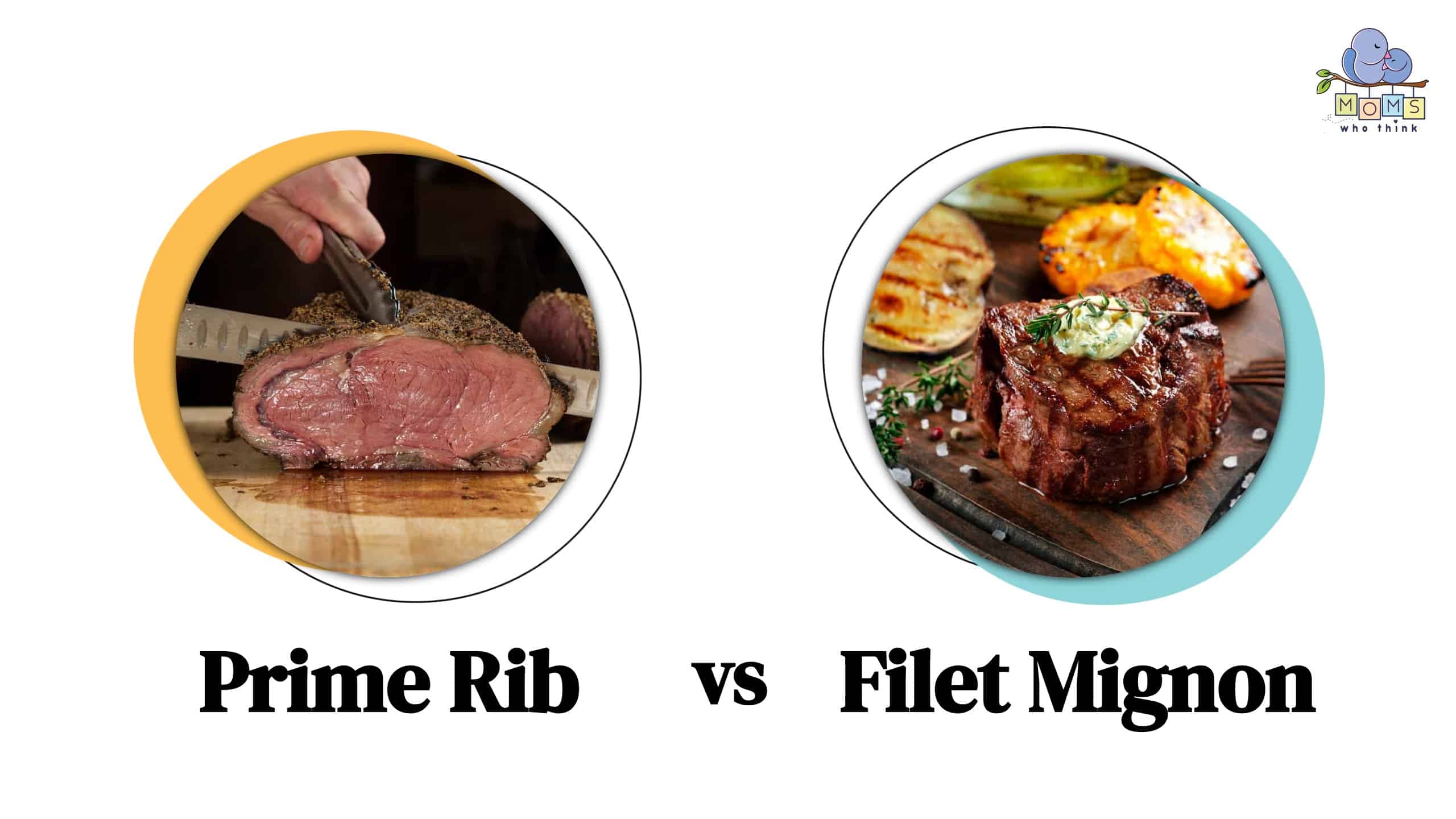When it comes to choosing the perfect steak for your next family meal or night out, the options can be overwhelming. Two extremely popular and delicious choices are prime rib and filet mignon. But what sets these cuts apart?
Whether you're a seasoned steak lover or a parent wanting to impress at your next family gathering, this post will guide you through the differences between both prime rib and filet mignon. We'll explore their unique qualities, cooking methods, and flavors. Let's dive in!
Prime Rib vs. Filet Mignon: What is the Difference?
While prime rib and filet mignon are both delicious and popular cuts of meat, they couldn't be more different from each other.
The primary difference between filet mignon and prime rib is the location of each cut. Prime rib is cut from the rib section while filet mignon comes from the tenderloin. Since the tenderloin is a rarely used muscle, filet mignon is incredibly tender whereas prime rib has a firmer texture.
Because prime rib is less tender, it's usually roasted over longer periods and served in larger portions. On the other hand, filet mignon is served in smaller, thick cuts that showcase its tenderness when served medium rare or even medium.
One final difference that's important is the flavor of each cut. Filet mignon doesn't have high amounts of marbling and has a more mild flavor while prime rib has more fat content that gives it more intense flavoring. Its often served with its natural juices to enhance its flavor.
Let's take a closer look at each steak.
Prime Rib vs. Filet Mignon: Which is Healthier (Calories, Fat, and More)
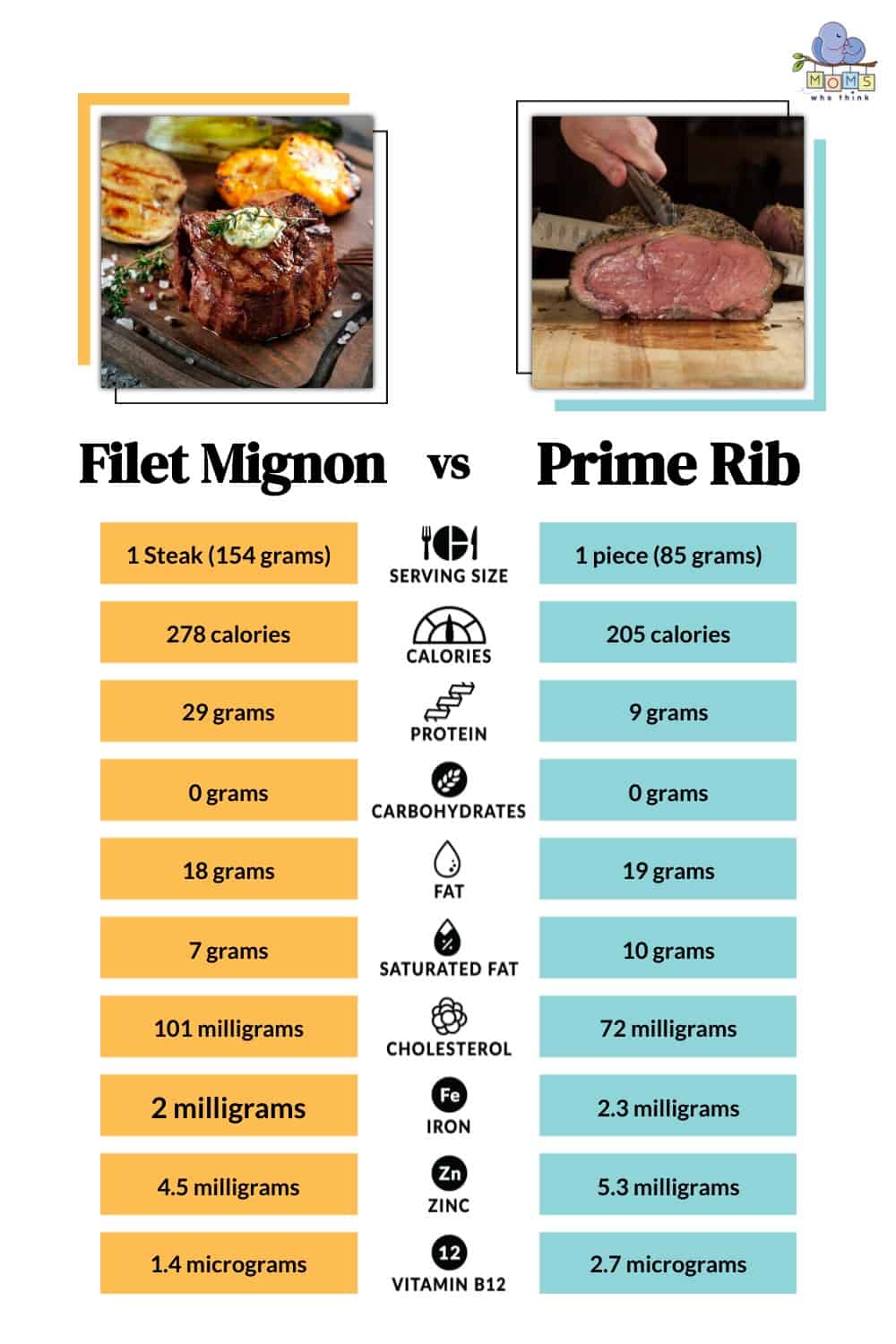
Prime rib contains more fat content relative to filet mignon, and as a result, also has more calories. You'll notice that a 3.5-ounce serving of prime rib comes with 19 grams of fat with more than half of those being saturated fat. Meanwhile, a 5.4-ounce serving of filet mignon has 18 grams of fat. While prime rib only has 9 grams of proteins per 3.5-ounce serving, filet mignon has three times that number in its standard serving size. Overall, filet mignon is a healthier cut of beef.
What Is Prime Rib?
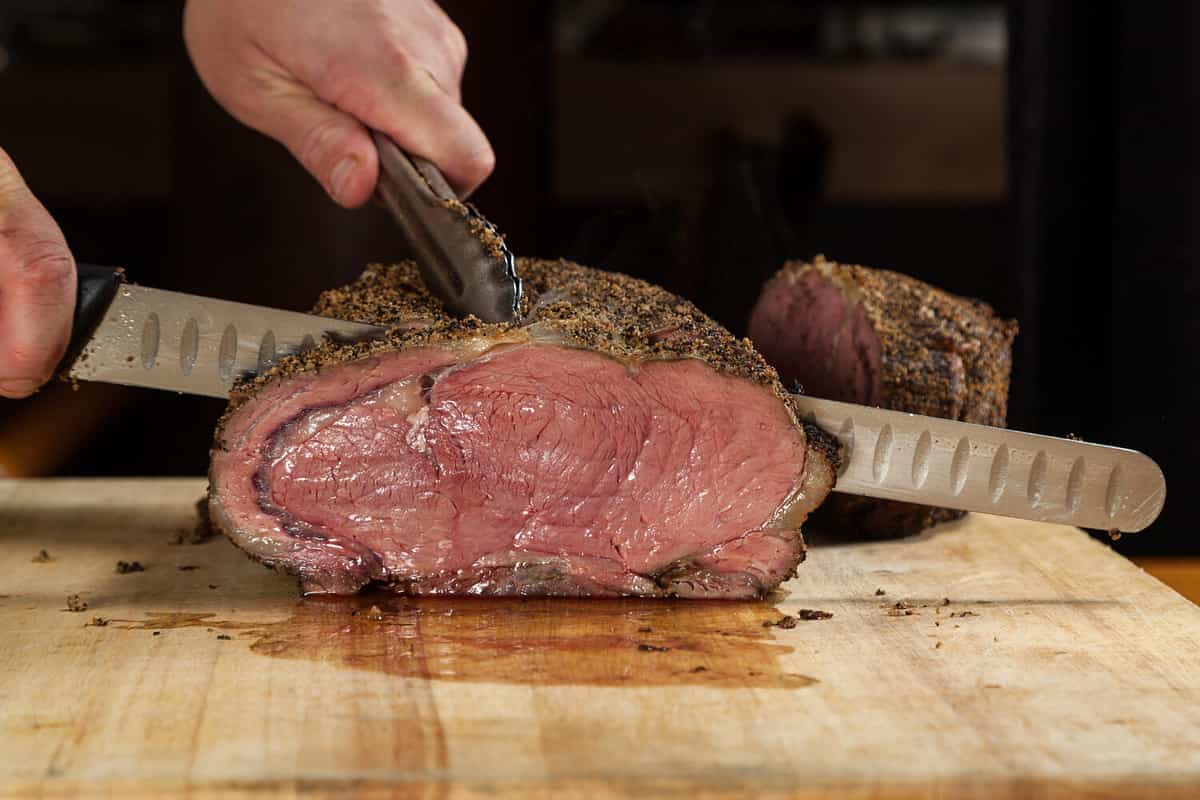
Prime rib is a large cut cooked medium rare and sliced before serving.
©Nature's Charm/Shutterstock.com
Prime rib is known for its rich beefy flavor and comes from the rib section of the cow. It's similar to a ribeye steak except that it's a much larger cut that is roasted and then sliced before serving. The word “prime” comes from the grading this cut receives from the USDA. Without the prime grading, this cut is simply a rib roast or a ribeye roast. Here's what you need to know about prime rib.
Meat Cut
As mentioned, the prime rib is cut from the rib section of a cow. Specifically, this cut spans from rib 6 to 12 and can be prepared with either the bone in or boneless. This is typically a much larger cut that can be a centerpiece for family meals, celebrations, or ordered individually at steak houses.
Texture and Appearance
Prime rib's texture is both firm and tender. It's not quite as tender as filet mignon as it tends to carry more fat), but cooked correctly, this cut of meat can be juicy and plenty tender.
Typically, when a prime rib is cooked, it has a dark appearance on the outside but remains pink on the inside when sliced for serving. This meat can also be prepared and served either with the bone in or boneless, which alters its appearance and sets it apart from most other cuts.
Flavor
We've touched lightly on prime rib generating its name from the “prime” grading it receives from the USDA. One of the things the USDA looks for when grading beef is marbling. Marbling is intramuscular fat that's common in red meat and prime rib is highly-marbled.
The marbling is what leads to prime rib's rich, beefy flavor. As the meat cooks, the fat melts, infusing the beef with its rich juices.
Cooking Method
Traditionally, prime rib is cooked by pan-searing the outside, then roasting the meat until it is medium-rare. This cut is often served with au Jus, which is simply a pan sauce that's made from the meat's natural juices.
When roasting prime rib, be sure to follow the following tips:
- Pan-searing is not necessary for prepping a prime rib. This meat can also just be roasted.
- Be sure the prime rib is placed on a rack in a roasting pan with the fat side facing up. This allows the fat to baste the meat while cooking.
- When roasting, be sure to keep the temperature low, usually around 325 degrees.
- The cooking time depends on the size of the roast and your desired level of doneness.
- To reach the coveted medium-rare consistency, cook the meat until the internal temperature reaches 135 degrees.
- When the meat is done cooking, it's important to let it rest for 15 to 30 minutes by tenting tin foil on top of it.
On top of roasting, a prime rib can also be grilled or smoked. Whichever method you use, this cut of beef is sure to be a crowd-pleaser.
What Is Filet Mignon?
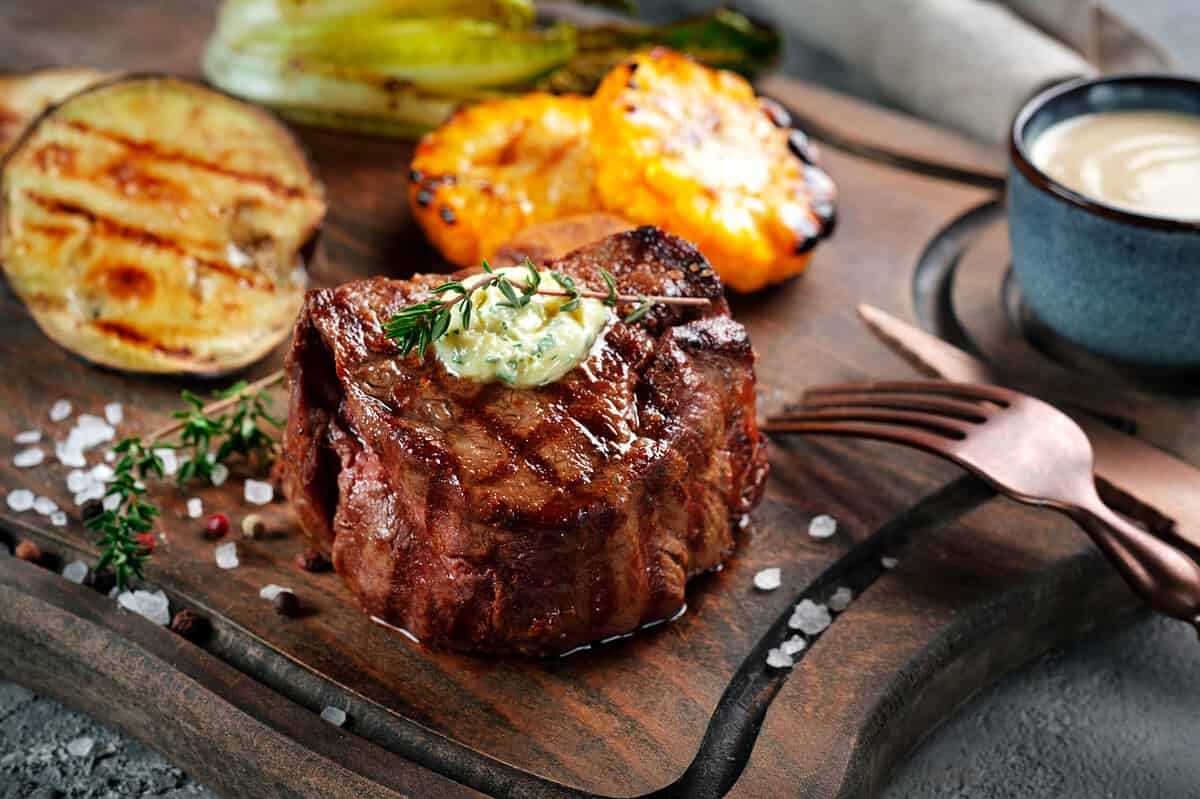
Filet mignon is typically a smaller cut and served with a butter sauce, similar to this.
©Andrei Iakhniuk/Shutterstock.com
In French, filet translates to “cute” and mignon translates to “dainty” or “small.” These words perfectly sum up the steak we're familiar with today. Filet mignon is a cut of beef that is most known for its tenderness and delicate flavor. Here's a closer look at its specifics.
Meat Cut
Unlike prime rib, filet mignon is cut from the smaller end of the beef tenderloin, not the rib section. The tenderloin is not a heavily used muscle which results in very little connective tissue or fat. Less connective tissue is what makes filet mignon known for its incredible tenderness.
Texture and Appearance
One of filet mignon's defining characteristics is its tenderness. This cut of beef has a very soft, buttery texture due to the cut coming from a non-weight-bearing muscle. Filet mignon is typically cut and sold at 1-2 inches thick. These steaks are typically small, weighing in at around 6-8 ounces, but they can be cut thicker or thinner depending on preference.
Flavor
One major factor that sets filet mignon apart from the prime rib is the marbling. Prime rib has a high amount of marbling, leading to a strong, beefy flavor, while filet mignon has hardly any marbling which gives this cut a delicate flavor. The lack of marbling can also make this cut of beef more prone to drying out if overcooked.
Cooking Method
Filet mignon can be prepared in a variety of ways, but it is most commonly grilled, broiled, or pan-seared. Because it doesn't have as strong of a flavor, it's often served with a rich sauce or topping, such as a red wine reduction or compound butter.
In general, filet mignon can handle a higher heat due to the fact that it has a lower fat content. Most often, high heat is first applied to sear both sides of the meat. Then it's left to cook at medium heat until it reaches the desired doneness.
Here are a few quick tips to cooking filet mignon in different ways:
- Grilling: Grill the filets for about 3-4 minutes per side for medium-rare, or until they reach the desired level of doneness. Let them rest for a few minutes before serving.
- Pan-seared: Heat a heavy skillet over high heat and add a small amount of oil. Sear the steaks for about 3-4 minutes per side for medium-rare, or until they reach the desired level of doneness. Finish them off with some butter and herbs in the pan to add flavor.
- Oven Roasted: Preheat your oven to 400°F and season the steaks with salt and pepper. Heat an oven-safe skillet over high heat and sear the steaks for 2-3 minutes per side. Transfer the skillet to the oven and roast for 6-8 minutes, or until the desired level of doneness is reached.
Should You Choose Prime Rib or Filet Mignon?
Ultimately, the choice between prime rib and filet mignon is up to you and your personal preferences. If you're looking to serve a large audience with a show-stopping and flavorful entree, prime rib is your best option. However, if you're looking to grill a couple of incredibly tender steaks with a delicate flavor for a night in, filet mignon is the way to go.
Keep in mind the cost difference between these two cuts as you decide on which one is best as well. Typically, a prime rib can be less pricey per ounce, but it may also be too large of a cut for your personal needs. Either way, experimenting with both cuts can provide a well-rounded steak experience and help you discover your personal favorite.
Steak Recipes
PrintThe Best Prime Rib
Ingredients
1 (4 to 5 pound) prime rib roast
1/3 cup olive oil
2 Tablespoons lemon juice
4 garlic cloves, minced
3 Tablespoons rosemary leaves
1 teaspoon pepper
Instructions
1. Place the roast in a shallow roasting pan and set aside 30 minutes to room temperature. Preheat oven to 450 degrees F.
2. Combine all other ingredients. Rub the prime rib with mixture. Bake 15 minutes until the meat begins to brown.
3. Reduce heat to 325 degrees F and continue cooking according to the chart below:
Cooking Time for Rare (120°) 3 Ribs, 7 to 8 lbs. 15 minutes at 450°, Then 1 ¼ to 1 ½ hours at 325° |
4. Every half hour or so, baste the ends of the roast with the drippings. Use the meat thermometer about 30 minutes before the end of the roasting time. Make sure to insert it in the thickest part of the meat, not touching the fat or bone.
When the internal temperature reaches 120°, remove roast from the oven and cover with foil. If you remove a prime rib from the oven when the temperature is over 125°, it will be way too dry and overdone.
5. Let the roast sit for twenty to thirty minutes. It will continue to cook during this time, reaching a temperature of about 125° to 130°. This resting period allows the juices and flavors to permeate the roast.
Final Thoughts
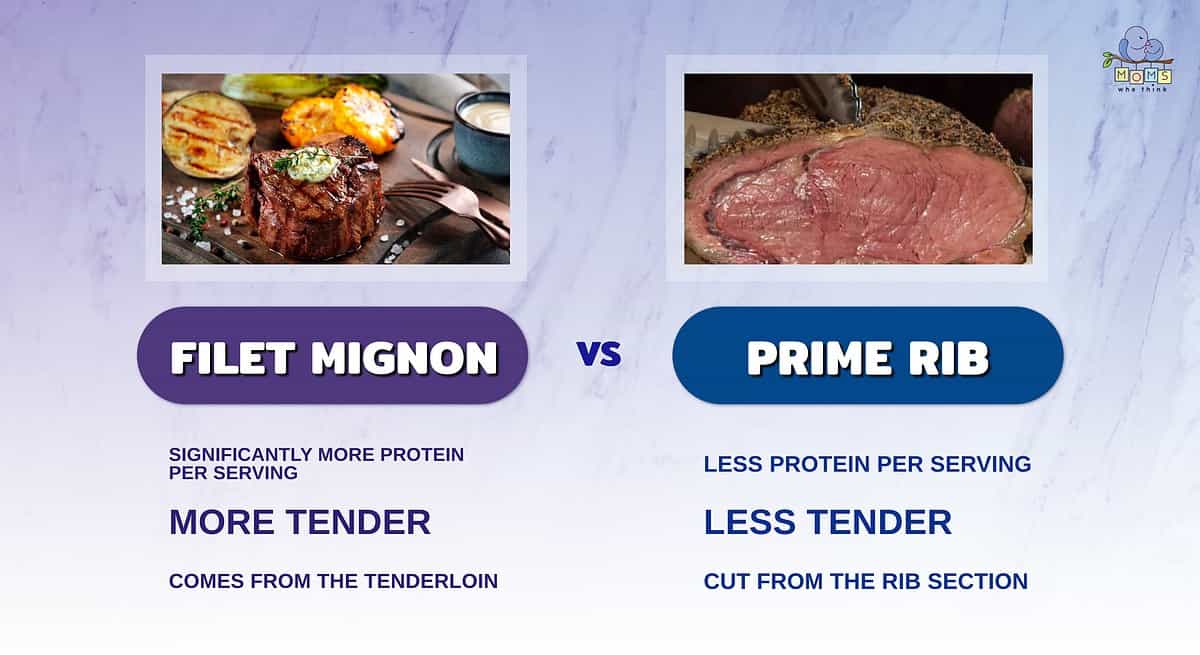
- Filet mignon has a lot more protein per serving than prime rib, making it a great choice for those looking to lose weight or build muscle.
- Since it's less tender, prime rib usually needs to be cooked for longer.
- Filet mignon comes from the tenderloin, while prime rib is cut from the rib section. This produces two different cuts of meat with their own distinct qualities.
In conclusion, while prime rib and filet mignon are both delectable and popular cuts of meat, they have distinct differences. Prime rib offers a rich, juicy flavor, while filet mignon has an ultra-tender texture and delicate taste. Understanding these differences can help you to choose the ideal steak for your next meal. Either option is sure to be delicious!
